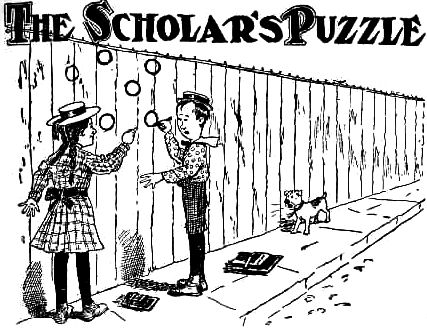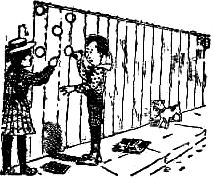



JENNIE was the brightest little girl in school; she carried off the highest honors in every branch of study, and, as a matter of fact, amused the entire school, teachers as well as scholars, with her clever tricks and puzzles. She met Joe the other day and showed him a new trick, which is just as pretty as it is clever. She drew six little rings on the fence and said: ÔÇťNow you can only see two rows of three in a line as I have placed them, but I want you to mark out one ring and place it somewhere else, so as to show four rows of three in a line.ÔÇŁ What an easy puzzle! Just change the position of one ring to as to have four rows, instead of but two.
JennieÔÇÖs trick was to move that one ring from the left to the extreme right as shown.

2. Rebus
All puzzle blocks give that famous address that the person gave who wrote to
W O O D
J O H N
M A M E
which it is said reached the intended destination of John Underwood, Andover, Maine; but they failed to mention that this printed letter here tells where the epistle was sent from:

If I am not very much mistaken the following illustration was intended to give an idea of the date.

John UnderwoodÔÇÖs letter must have come from the Keystone state and was dated ÔÇťfried A.ÔÇŁ
3. The Kangaroo Puzzle
Being an old sailor with a penchant for spinning yarns that require considerable saline seasoning. I do not mind telling you in strict confidence that I pirated the idea of this puzzle from the taffrail of a Dutch jigger which I saw riding at anchor in the bay during my last trip to Australia. I jotted down in my notebook at the time the suggestion that there was a possibility of every word having a mechanical peculiarity of its own, susceptible of being illustrated in puzzle form. As a proper souvenir of the occasion I present the following sketch of the taffrail of that boat. The name was painted in the twelve upper rings, and I suggested to my companion that it would make a pretty puzzle to find in how few moves the name could moved down to the lower row. Astonishing as it may appear, it is safe to say that all of our puzzlists will know the name of that Dutch jigger when they have solved the puzzle.

Select a word of twelve letters, and place the letters in their proper order in the upper row of the rings, one letter in each ring. Then move them down one step at a time, or jump one letter over another when possible, so as to spell the same word correctly in the lower row of rings, in the fewest possible moves. I think it was the jumping feature that suggested the name, or I might have described it as a Shakespearian puzzle, for though you may ask, ÔÇťWhat's in a name?ÔÇŁ you will find, as Hamlet says, ÔÇťThe playÔÇÖs the thingÔÇŁ wherein ÔÇťto suit the action to the word and the word to the action,ÔÇŁ if you wish to perform the feat expeditiously.
The Kangaroo puzzle can be solved by any 12-letter word in more or less moves. The object, therefore, was to find a word which would best suit the play. The title of the puzzle; the reference to a bay in Australia and other hints were given as aids to the word ÔÇťWooloomooloo,ÔÇŁ which solves the problem in twenty moves.
4. A Rebus
My first earns his bread by the sweat of his brow,
Till my second compels him to cease;
When, if wise, what he gained by my whole may allow
Him to spend his last days more at ease.
Cipher Answer.ÔÇ” 16, 15, 18, 20, 5, 18. 1, 7, 5.
PORTERAGE
5. A Charade
A well known tree transposed aright,
Will turn the darkness into light
Cipher Answer. ÔÇ” 16, 1, 12, 13.
PALM
6. Pictorial Algebra.

Here is an elementary study in arithmetic wherein you write down the names of all the articles, and then cancel out all the articles so as to tell what remains. If you guess the names correctly it becomes a very simple puzzle.
The Pictoral Algebra reads: Pins + hoes + cart -shoes - car = pint.
[Page 59]